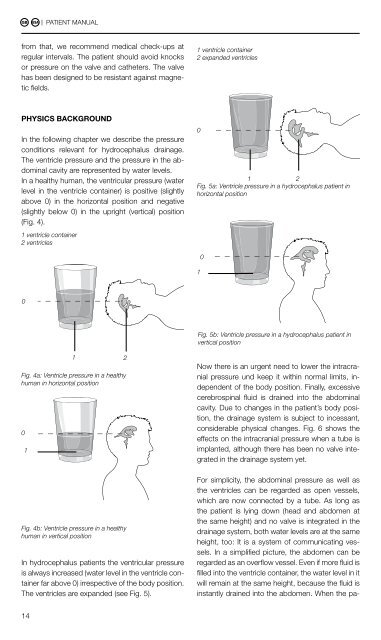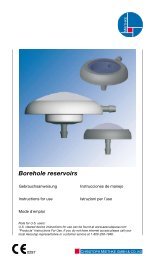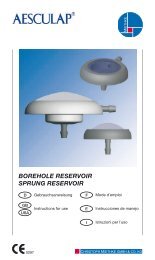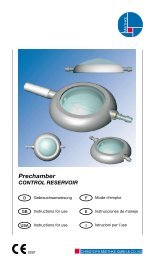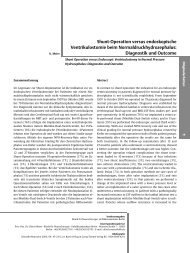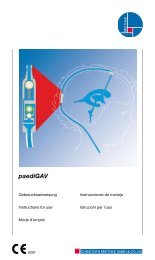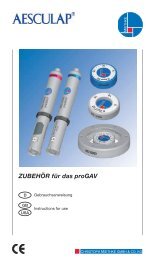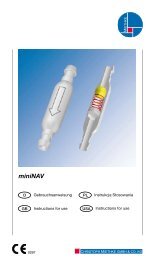proGAV® - Christoph Miethke GmbH & Co. KG
proGAV® - Christoph Miethke GmbH & Co. KG
proGAV® - Christoph Miethke GmbH & Co. KG
Create successful ePaper yourself
Turn your PDF publications into a flip-book with our unique Google optimized e-Paper software.
GB<br />
| Patient manual Patient manual |<br />
from that, we recommend medical check-ups at<br />
regular intervals. The patient should avoid knocks<br />
or pressure on the valve and catheters. The valve<br />
has been designed to be resistant against magnetic<br />
fields.<br />
physics bac<strong>KG</strong>roUnD<br />
In the following chapter we describe the pressure<br />
conditions relevant for hydrocephalus drainage.<br />
The ventricle pressure and the pressure in the abdominal<br />
cavity are represented by water levels.<br />
In a healthy human, the ventricular pressure (water<br />
level in the ventricle container) is positive (slightly<br />
above 0) in the horizontal position and negative<br />
(slightly below 0) in the upright (vertical) position<br />
(Fig. 4).<br />
1 ventricle container<br />
2 ventricles<br />
0<br />
1 2<br />
Fig. 4a: Ventricle pressure in a healthy<br />
human in horizontal position<br />
0<br />
1<br />
Fig. 4b: Ventricle pressure in a healthy<br />
human in vertical position<br />
In hydrocephalus patients the ventricular pressure<br />
is always increased (water level in the ventricle container<br />
far above 0) irrespective of the body position.<br />
The ventricles are expanded (see Fig. 5).<br />
1 ventricle container<br />
2 expanded ventricles<br />
0<br />
1 2<br />
Fig. 5a: Ventricle pressure in a hydrocephalus patient in<br />
horizontal position<br />
1<br />
0<br />
Fig. 5b: Ventricle pressure in a hydrocephalus patient in<br />
vertical position<br />
Now there is an urgent need to lower the intracranial<br />
pressure und keep it within normal limits, independent<br />
of the body position. Finally, excessive<br />
cerebrospinal fluid is drained into the abdominal<br />
cavity. Due to changes in the patient’s body position,<br />
the drainage system is subject to incessant,<br />
considerable physical changes. Fig. 6 shows the<br />
effects on the intracranial pressure when a tube is<br />
implanted, although there has been no valve integrated<br />
in the drainage system yet.<br />
For simplicity, the abdominal pressure as well as<br />
the ventricles can be regarded as open vessels,<br />
which are now connected by a tube. As long as<br />
the patient is lying down (head and abdomen at<br />
the same height) and no valve is integrated in the<br />
drainage system, both water levels are at the same<br />
height, too: It is a system of communicating vessels.<br />
In a simplified picture, the abdomen can be<br />
regarded as an overflow vessel. Even if more fluid is<br />
filled into the ventricle container, the water level in it<br />
will remain at the same height, because the fluid is<br />
instantly drained into the abdomen. When the pa-<br />
tient stands up, the ventricles are at a significantly<br />
higher level than the abdomen. In this case, the<br />
fluid is drained through the tube until both water levels<br />
are at the same height. This means, however,<br />
that the ventricle container is emptied completely.<br />
Since the ventricles do not have rigid walls, this<br />
emptying leads to a contraction of the ventricles.<br />
This, in turn, can result in the above mentioned<br />
blockage of the drainage system. The cerebrospinal<br />
fluid is sucked out of the ventricles and the<br />
brain suffers deformation. And when the brain contracts,<br />
the resulting open space between brain and<br />
skull bone can fill up with water or blood (Fig. 6).<br />
1 ventricle container<br />
2 ventricle<br />
3 drainage tube<br />
4 abdominal cavity<br />
5 abdominal container<br />
6 accumulated water or blood<br />
7 contracted ventricles<br />
Fig. 6: Ventricle drainage without a valve<br />
a) horizontal, b) vertical<br />
14 15<br />
0<br />
a) 1 2 3 4 5<br />
b)<br />
1<br />
5<br />
0<br />
0<br />
A conventional valve integrated into the drainage<br />
system causes a rise of the water level in the ventricle<br />
container, by exactly the opening pressure of<br />
the valve. Now, the two containers “communicate”<br />
only when the valve is open. When the patient<br />
stands up, cerebrospinal fluid is drained off until<br />
the height difference between the two containers<br />
for the horizontal position is reached. However, the<br />
opening pressure of the valve, which was adjusted<br />
for the horizontal position, is considerably lower<br />
6<br />
7<br />
3<br />
4<br />
than the pressure corresponding to the height difference<br />
between the ventricles and the abdomen.<br />
Hence, the ventricles will still drained empty, resulting<br />
in the above mentioned problems (Fig. 7).<br />
1 ventricle container<br />
2 ventricle<br />
3 drainage tube<br />
4 abdominal cavity<br />
5 abdominal container<br />
6 accumulated water or blood<br />
7 contracted ventricles<br />
8 valve<br />
x<br />
a) 1 2 3 4 5<br />
0<br />
1<br />
b)<br />
x<br />
5<br />
8<br />
Fig. 7: Ventricle drainage with conventional valve<br />
a) horizontal, b) vertical<br />
The following sketch demonstrates the importance<br />
of implanting a valve that offers a significantly higher<br />
opening pressure for the vertical position (corresponding<br />
to the distance between the brain and<br />
the abdomen) than for the horizontal position.<br />
The proGAV is such a valve. It sets the required intracranial<br />
pressure for the patient in every body position.<br />
The problems and complications described<br />
above are avoided by preventing any unintentional<br />
overdrainage of cerebrospinal fluid (Fig. 8).<br />
6<br />
7<br />
3<br />
4<br />
GB


